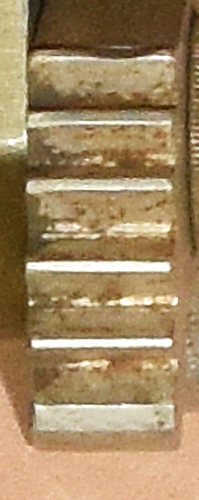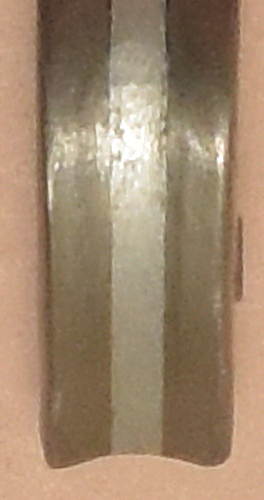Overview
[ Top
| Cable v. A
| Cable v. B
| Cable v. C
| Cable v. D
| Rope v. A
| Rope v. B
| Return to L.C. Ascenders
]
Bogibbs
(#3624)
Technical Details
Artyom Babin (Артём Бабин) sent me this Bogibbs in 2023.
 This Bogibbs is 90 mm. tall, 75 mm. wide, 27 mm. thick, and weighs 161 g.
This Bogibbs is 90 mm. tall, 75 mm. wide, 27 mm. thick, and weighs 161 g.
The body is milled from aluminum alloy and soft anodized. The rope channel is 13 mm. wide. The front is cut away to admit the rope for rigging.
The cam is milled from aluminum alloy. The cam radius increases from 22 to 33 mm. over an angle of 57°, giving a 22° cam angle. The teeth are formed by five triangular grooves, leaving six teeth. A custom stainless-steel bolt connects the cam to the shell and serves as the cam axle. A spring-loaded plunger on the rear of the cam limits the cam motion so that the remove cannot escape. This plunger must be depressed when rigging or derigging.
There are no markings on this ascender.
This ascender develops Gustav Stibrányi's Bogibbs design. The plunger is a unique feature that is not strictly necessary, but helps keep the rope from accidentally coming out of the ascender during use. A second advantage is that it limits the cam motion when lifting a foot-mounted ascender, improving climbing efficiency.
[ Top
| Bogibbs
| Cable v. B
| Cable v. C
| Cable v. D
| Rope v. A
| Rope v. B
| Return to L.C. Ascenders
]
Cable Ascender, Version A
(#103)
Technical Details
I acquired this Russian cable ascender from Ed Sira at the 1993 Old Timers Reunion.
This ascender is 90 mm. tall, 45 mm. wide, 33 mm. thick, and weighs 175 g. The frame
is bent from sheet steel, and the cam is milled from steel plate.
The cam face has three shallow grooves, giving the ascender two
low-relief teeth. The cam axle is a steel pin that is retained
by a steel cable passing through a hole in the end of the pin.
Two sets of holes in the shell allow the cam to be positioned
for climbing different size cable.
There are no markings on this ascender.
This ascender is not as crudely made as it first appears, since
most of the illusion is due to the loose cable ends.
The ascender is designed to be used on cable, but can also
be used on 9 mm. rope if the cam is in the outer position.
[ Top
| Bogibbs
| Cable v. A
| Cable v. C
| Cable v. D
| Rope v. A
| Rope v. B
| Return to L.C. Ascenders
]
Cable Ascender, Version B
(#3578)
Technical Details
Artyom Babin (Артём Бабин) sent me this Russian cable ascender in 2022.
This ascender is 92 mm. tall, 68 mm. wide, 34 mm. thick, and weighs 147 g. The frame
is bent from sheet steel, and the cam is milled from aluminum plate.
The cam face is smooth and lacks a groove. The cam axle is a steel pin that is retained
by a steel cable passing through a hole in the end of the pin.
Two sets of holes in the shell allow the cam to be positioned
for climbing different size cable.
There are no markings on this ascender.
This ascender is not as crudely made as it first appears in the photo. The illusion is due to the age and use of this ascender and the loose cable ends.
The ascender is designed to be used on cable, but can also
be used on 9 mm. rope if the cam is in the outer position.
The aluminum cam makes this ascender lighter than Version A, but steel cable will abrade the aluminum cam faster than it will the steel cam on Version A.
[ Top
| Bogibbs
| Cable v. A
| Cable v. B
| Cable v. D
| Rope v. A
| Rope v. B
| Return to L.C. Ascenders
]
Cable Ascender, Version C
(#3582)
Technical Details
Artyom Babin (Артём Бабин) sent me this Russian cable ascender in 2023.
This ascender is 79 mm. tall, 79 mm. wide, 34 mm. thick, and weighs 168 g. The frame
is bent from stainless steel sheet, and the cam is milled from stainless steel.
The cam face is smooth and lacks a groove. The cam axle is a stainless steel pin that is retained
by a stainless steel cable passing through a hole in the end of the pin.
Two sets of holes in the shell allow the cam to be positioned
for climbing different size cable.
There are no markings on this ascender.
The ascender is designed to be used on cable, but can also
be used on 9 mm. rope if the cam is in the outer position.
This ascender is nicely made. The stainless steel cam adds weight compared to an aluminum cam, but it provides superior wear resistance. This is especially noticeable when climbing steel cable.
[ Top
| Bogibbs
| Cable v. A
| Cable v. B
| Cable v. C
| Rope v. A
| Rope v. B
| Return to L.C. Ascenders
]
Cable Ascender, Version D
(#3627)
Technical Details
I acquired this Russian Cable Ascender from Artyom Babin (Артём Бабин) in 2023. He dates it to the 1980s.
This ascender is 94 mm. tall, 73 mm. wide, 41 mm. thick, and weighs 170 g. The frame is bent from titanium alloy sheet, and the cam is cut from stainless steel. The rope channel is 15 mm. wide.
The cam radius increases from 14 to 28 mm. over an angle of 93°, giving a 22° cam angle. The cam face is smooth and lacks a groove. The cam axle is a stainless steel pin that is retained by a stainless steel cable keeper that passes through a hole in the end of the pin and a hole in the cam. Two sets of holes in the shell allow the cam to be positioned for climbing different size cable.
There are no markings on this ascender.
The ascender is designed to be used on cable, but can also
be used on 9 mm. rope if the cam is in the outer position.
This ascender is nicely made. The stainless steel cam adds weight compared to an aluminum cam, but it provides superior wear resistance. This is especially noticeable when climbing steel cable.
[ Top
| Bogibbs
| Cable v. A
| Cable v. B
| Cable v. C
| Cable v. D
| Rope v. B
| Return to L.C. Ascenders
]
Rope Ascender, Version A
(#96, 2259)
Technical Details
I acquired my Russian rope ascender from John E. Weinel, Inc. at the 1994 Old Timers Reunion. I acquired another in 2017 as part of Bob Thrun’s collection.
The Russian rope ascender is 46 mm. tall, 72 mm. wide, 28 mm. thick, and weighs 97 g. The frame and cam are milled
from aluminum, and the cam is permanently bolted to the frame.
A swinging side plate is riveted to the upper side of the frame.
There are no markings on this ascender.
John Weinel found this nice little ascender in 1994, and imported
it as a novelty device. I like the design because it is different
than many of the western designs.
After the rope is inserted, the side plate is closed and slings
are attached with a carabiner or maillon that passes through both
the cam eye and the oval hole in the side plate. As the climber
climbs, the side plate rotates with the cam. The oval hole allows
this, even though the two parts are pivoting about different points.
One disadvantage of this system is that it is not conducive to
sewing slings to the ascender.
As with all short ascenders, this one rotates significantly
in use, resulting in lost motion.
[ Top
| Bogibbs
| Cable v. A
| Cable v. B
| Cable v. C
| Cable v. D
| Rope v. A
| Return to L.C. Ascenders
]
Rope Ascender, Version B
(#3643)
Technical Details
 I acquired this ascender from Artyom Babin (Артём Бабин) in 2024.
I acquired this ascender from Artyom Babin (Артём Бабин) in 2024.
This ascender is 62 mm. tall, 78 mm. wide, 25 mm. thick, and weighs 131 g.
The shell is bent from 1.9 mm. titanium alloy. The rope channel is 15 mm. wide. A 14.5 mm. carabiner hole is drilled above the cam. The cam pivots on a 5.9 mm. flat-head titanium pin. This pin is secured to the shell with a 0.5 mm. steel cable keeper. A 2.25 mm. steel cable pinned to the shell passes through a hole near the end of the pin, holding it in place. The end of this cable can be removed from that hole to allow opening the ascender for rigging.
The cam is made from a 4 mm. aluminum alloy plate sandwiched between two 5 mm. titanium alloy plates. The three plates are held together by two six m. steel rivets. The cam face is smooth with no teeth. The cam radius increases from 24 to 36 mm. over an angle of 46°, giving a 28° cam angle. There is a 14 mm. attachment hole at the outer end of the cam, and a smaller lightening hole between the cam pivot hole and the cam face.
There are no markings on this ascender.
This ascender appears to be designed for rope only. The cam lacks the second pivot hole found on the cable ascenders on this page. When using the existing hole, it does not provide enough friction to hold on steel cable, It will slide freely down any rope or cable under 7 mm. in diameter. For larger ropes, it slips more easily than many other lever-cam ascenders.
As with all short ascenders, this one rotates significantly
in use, resulting in lost motion.
[ Top
| Bogibbs
| Cable v. A
| Cable v. B
| Cable v. C
| Cable v. D
| Rope v. A
| Rope v. B
]


